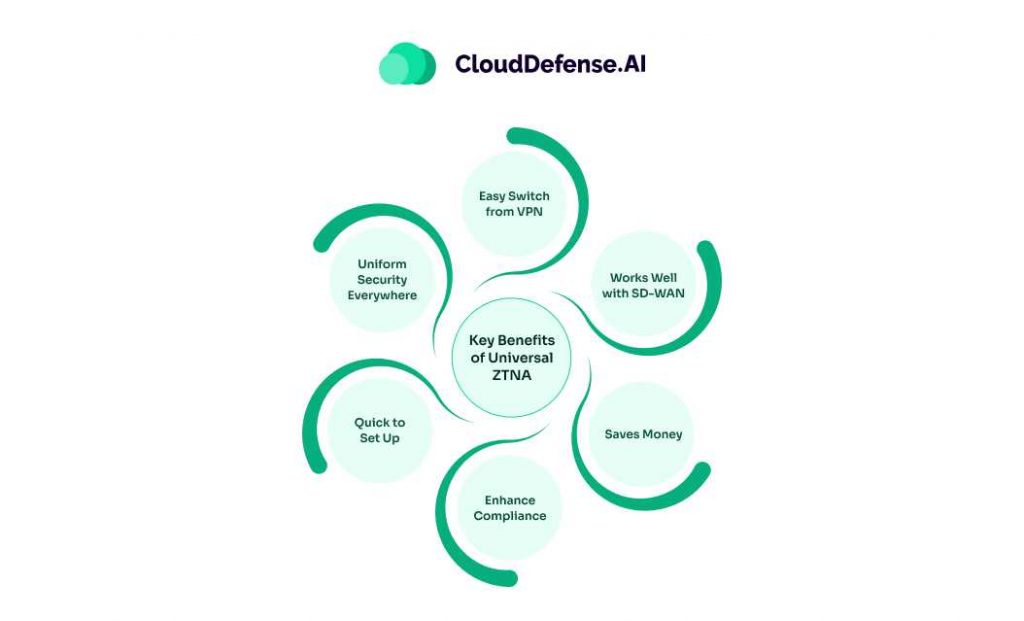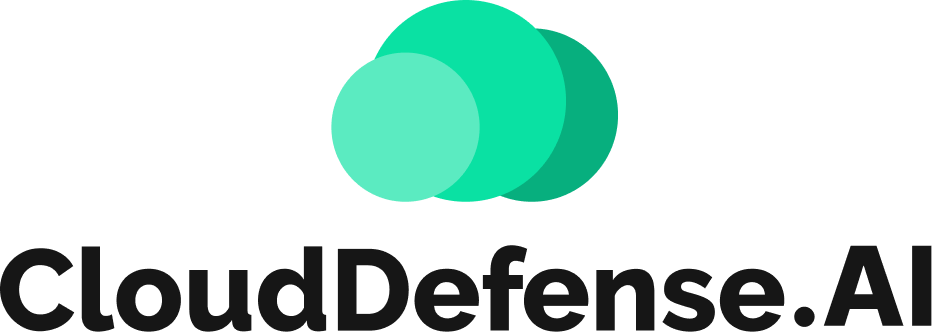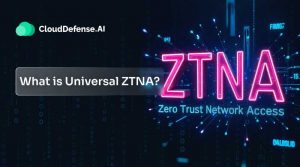What is Universal ZTNA?
Universal ZTNA, or Zero Trust Network Access, is a comprehensive strategy for securing digital assets and networks. It operates on the principle of treating all users and devices as potential threats until their identity is verified. This approach is applicable everywhere—whether in the office, at home, or on the go.
What sets Universal ZTNA apart is its flexibility. It works with cloud services, on-premises solutions, or a combination of both, maintaining the core principle of not assuming trust by default. This means that every access request is subject to strict verification, including multiple forms of authentication, even after the initial access is granted. This ensures that your data remains secure regardless of where your team is working from.
Let’s look at a simple example:
Picture this: You’re working on a sensitive project from a café. You connect to your company’s network, but instead of instant access, you’re met with a series of checkpoints. First, you enter your password. Then, your phone buzzes—a one-time code appears. You input it, and you’re in… sort of.
As you navigate to different applications, each one asks for verification. Opening a document? Prove it’s you. Accessing customer data? Another check. Even after a short coffee break, you’re prompted to re-authenticate.
This constant verification isn’t just annoying security theater. It’s Universal ZTNA in action. It’s treating every access attempt as potentially risky, whether you’re in the office or sipping a latte halfway across the world.
The system is always asking: “Are you really who you claim to be? Should you access this right now?” It’s a perpetual game of digital “Simon Says,” where the rules of access are continuously enforced, keeping your company’s critical data safe in an threat-filled digital front.
Why is Universal ZTNA becoming a critical investment for enterprises?
Let’s discuss why Universal ZTNA is becoming a big deal for businesses today. It’s about giving everyone in the company a safe and easy way to access work stuff, no matter where they are or what device they’re using.
Here’s the thing – a lot of companies are struggling with some key issues:
- Is your network really safe when people log in from different places?
- Do your employees get frustrated with different login steps depending on where they’re working?
- Can your IT team keep track of all the different ways people are accessing the network?
Universal ZTNA helps fix these problems. It makes sure security is the same everywhere, so employees don’t have to deal with confusing login processes. It’s especially helpful now that so many people are working from home or splitting time between home and office.
Without this kind of system, you might run into some real headaches. Hackers could find weak spots in your security, employees might try to bypass tricky login steps, and your IT team could get swamped trying to keep everything safe.
By using Universal ZTNA, you’re making things easier and safer for everyone. New employees can get up and running quickly, and everyone can work securely whether they’re at home, in the office, or on the go.
So, is it worth investing in? Well, with cyber attacks on the rise and more people working remotely than ever, it’s definitely something to think about. It’s not just about better security – it’s also about making work smoother for your employees and taking some pressure off your IT team.
Difference between ZTNA vs Universal ZTNA
Let’s break down the real difference between ZTNA and Universal ZTNA. It’s all about flexibility and consistency.
Regular ZTNA can be a bit of a challenge. Depending on where you’re working from, you might run into different security hoops to jump through. Sometimes, an app works fine from the office, but try to use it from home, and you’re out of luck. It’s secure, sure, but it can be frustrating.
Universal ZTNA fixes that headache. It doesn’t care if you’re at your desk, on your couch, or working from a beach. The security checks are the same everywhere. This means you can truly work from anywhere without running into weird access issues.
For the IT team, Universal ZTNA is a huge win. They don’t have to set up different security rules for every possible scenario. They can create one set of policies that works across the board. It’s simpler to manage and leaves fewer chances for security gaps.
The big takeaway? Universal ZTNA lets companies embrace remote work without compromising on security. It’s the same strict security everywhere, just without the location-based hassles.
Key Benefits of Universal ZTNA

1. Uniform Security Everywhere
Universal ZTNA applies the same tough security rules no matter where people connect from. This beats cloud-based ZTNA, which might leave some important systems open to attack. With Universal ZTNA, everyone faces the same strong security checks.
2. Easy Switch from VPN
Moving from VPN to Universal ZTNA is pretty simple, especially if one company handles both. You won’t need different setups for VPN and on-site connections, which makes things a lot easier to manage.
3. Works Well with SD-WAN
You can use Universal ZTNA alongside SD-WAN to boost security without slowing things down. This keeps access rules the same across your network, even when SD-WAN changes how it handles data or app access.
4. Saves Money
Using Universal ZTNA means you only pay for one system to protect everything. This cuts down on fees and the people needed to keep things running smoothly. You’ll likely spend less on upkeep and upgrades, too.
5. Enhance Compliance
If your company needs to meet strict security standards, Universal ZTNA helps a lot. It protects everything the same way, making it easier to pass audits. With other systems, some parts might pass while others fall short.
6. Quick to Set Up
Unlike other options that can take forever to get going, you can set up Universal ZTNA in just a few days. This gets you up and running with better security much faster.
Why is Universal ZTNA crucial for putting zero-trust principles into action across your whole network?
Think about it — if you’re using a mix of private clouds, public clouds, and various online services, how do you make sure everything’s secure? Without Universal ZTNA, it’s a real headache. You might end up having to choose between good security and easy access, which isn’t ideal.
Here’s a real-world example:
Let’s say your company has an important app running on computers in your office. When people are at work, they have to jump through several security hoops to use it – like logging in again if they’ve been idle for a few minutes or providing multiple forms of ID. That’s zero-trust in action, and it’s good.
But what about when people work from home? Often, they just connect through a VPN with a simple username and password. See the problem? All that effort to be secure in the office goes out the window because now a hacker only needs to figure out someone’s login details to get in.
This is where Universal ZTNA shines. It makes sure everyone goes through the same security steps, whether they’re in the office or working from their couch. It doesn’t matter where your stuff is – on your own computers, in the cloud, or spread across different online services. Universal ZTNA keeps it all locked down tight. It’s about keeping things consistent and secure, no matter where people are connecting from.
Enforcing Zero Trust with Universal ZTNA
Zero Trust Network Access (ZTNA) eliminates implicit trust, ensuring that every user, device, and application must be continuously verified before accessing resources. Implementing Universal ZTNA requires a strategic approach that includes:
- Identity-Centric Access Control: Enforce authentication based on user identity, device posture, and contextual factors (e.g., location, time of access).
- Least Privilege Enforcement: Grant only the minimum necessary access for users and applications, reducing attack surfaces.
- Microsegmentation: Restrict lateral movement by segmenting networks and isolating workloads to prevent unauthorized access.
- Continuous Monitoring and Adaptive Security: Leverage AI-driven analytics and real-time threat detection to assess risk and dynamically adjust access policies.
- Secure Access Everywhere: Extend Zero Trust policies across cloud, on-premises, and hybrid environments, ensuring consistent security controls.
A successful Universal ZTNA implementation provides organizations with a scalable, secure framework to protect data and applications from evolving threats while improving user experience.
Conclusion
With Universal ZTNA, organizations can lock down critical assets, verify every request, and stop threats before they spread. The key is consistency: applying Zero Trust across all environments, from cloud to on-prem. It’s not about making access harder; it’s about making security smarter. In a world where attacks are inevitable, trusting nothing and verifying everything is the only way forward.







